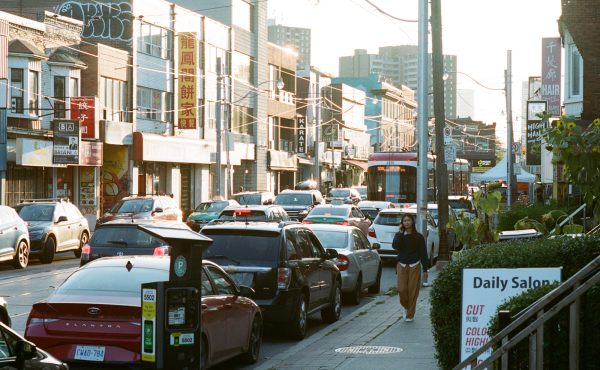
Streets are at the heart of a city. They take up a quarter of all land in the city. They should be the places where people gather and experience urban life. They enable people to move and do their business. They are the interchange between public and private spaces. Toronto’s official plan calls on the city to transform its streets into truly urban pedestrian-friendly, bike- and transit-oriented spaces that do more than just move cars. But to do that, the city needs to change the way it thinks about and manages streets.
Two Toronto academics have recently published a remarkable study analyzing how Toronto’s streets are made and changed, in order to set the stage for a new way of making streets in Toronto. Written by Paul Hess of the University of Toronto and Beth Milroy of Ryerson University, it is called “Making Toronto’s Streets” (PDF – large file). The study was inspired by pedestrian activists Janice Etter and Rhona Swarbrick, who have long identified Toronto’s street classification system and street building processes as a key obstacle to the process of creating pedestrian-oriented streets.
The report comes at an opportune time, when urbanists like Christopher Hume and Glen Murray are talking about the need to make Toronto’s streets into destinations rather than thoroughfares. A key step in accomplishing this goal is to get the city to incorporate pedestrian and cycling improvements every time it rebuilds a street anywhere in Toronto, not just on occasional projects where there is an active local community who can push the city to think broadly (such as the recent revitalization of College Street between Spadina and Bathurst). By analyzing exactly how a street is built or rebuilt in the current system, Hess and Milroy have made a really valuable contribution that points to where and how to change the system.
A good opportunity to make this change happen lies in the City’s initiative to develop a Toronto Pedestrian Plan, which needs to incorporate this concept into city policy. And there is political support for this idea — many councillors said they were in favour of this proposal in the election survey put out by the Toronto Coalition for Active Transportation. At Spacing’s “Political Party” mayoral event, when Mayor David Miller was asked:
Although the official plan calls for Toronto to become a pedestrian-friendly city, at the moment when streets are rebuilt, the city rarely does anything to improve the street for pedestrians. Will you change city processes so that pedestrian improvements are considered and implemented in all street reconstructions and new developments, as a matter of course?
He simply answered “yes.” So the commitment is there, and now it’s time to make it happen.
On a side note, the importance of this idea of streets as destinations that knit the surrounding urban spaces together comes from a new trend of shopping malls that are centred around an open-air “public square” accessed by pedestrian walkways, mimicking a traditional downtown shopping ambience. Of course, they are surrounded by parking lots and you have to drive to get there. Imitation is the sincerest form of flattery, but it seems absurd and depressing to build isolated, artificial urban spaces when one could, instead, build real ones.
“It’s sort of like a streetscape turned inside out in terms of the pedestrianization,” says University of Toronto sociologist Joe Hermer, who has studied a movement called town centre management in British urban areas. “They’re trying to co-opt the feeling of walking down a lively downtown street. The irony of it is you have to drive to it.”
photo looking north on Yonge St. during subway construction, 1950.
from Toronto Archives: fonds 1257, series 1057, item 8939




One comment
Paul Hess is brilliant, and an asset to the city of Toronto. His examination of what it means to be a pedestrian in the suburbs of Seattle is a must-read, especially with reference to the jargon about the “five minute walking radius” that permeates much discussion of walkable neighbourhood design.
It will be interesting to see if he and Beth Milroy’s work can give “teeth” to the Pedestrian Charter.